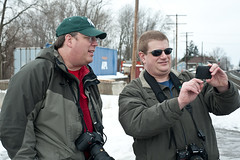 Cameraphone refers not just to phones with built-in cameras, but to many small standalone devices using the same chips as are built into cameraphones. They generally have lenses without optical zoom capabilities, instead offering a digital zoom if anything. That makes them smaller and lighter but inhibits the quality of the image. (Much of the difference between cameras is actually in the optics rather than the sensor, and a digital zoom simply crops in on the image reducing quality and resolution.) They usually lack an iris to control the light depending instead on changing the sensitivity and length of the exposure which limits their usability in extreme lighting conditions. Despite these drawbacks, there's two things which make phones great cameras. When coupled with a data plan they can send images or videos immediately from just about anywhere. You can e-mail a photo to a cache owner, upload to a web photo gallery, or even tweet without connecting through a computer. The other factor is they're small, weight very little, and you're most likely already carrying one. That last point is what makes it such a wonderful tool for Geocachers.
Cameraphone refers not just to phones with built-in cameras, but to many small standalone devices using the same chips as are built into cameraphones. They generally have lenses without optical zoom capabilities, instead offering a digital zoom if anything. That makes them smaller and lighter but inhibits the quality of the image. (Much of the difference between cameras is actually in the optics rather than the sensor, and a digital zoom simply crops in on the image reducing quality and resolution.) They usually lack an iris to control the light depending instead on changing the sensitivity and length of the exposure which limits their usability in extreme lighting conditions. Despite these drawbacks, there's two things which make phones great cameras. When coupled with a data plan they can send images or videos immediately from just about anywhere. You can e-mail a photo to a cache owner, upload to a web photo gallery, or even tweet without connecting through a computer. The other factor is they're small, weight very little, and you're most likely already carrying one. That last point is what makes it such a wonderful tool for Geocachers.Compact cameras come in a range from simple to advanced usually providing better image quality and options than the cameraphones. Many include both optical and digital zooms, while still remaining small and light. These lenses are usually targeted at the general user who want to shoot photos at parties, and of children playing, but not the birds in the far off trees, so don't look for large magnification factors here. (Remember that when a camera is said to have a "3X Zoom" that refers only to the range of the zoom from the widest to most telephoto lengths and not to the magnification factor.) A few compact cameras are sealed to shoot underwater, in the rain, snow, and mud without damaging the camera itself. Finding a camera like this, built with some shock resistance as well, makes a great option for a camera on the trail. Generally they don't allow for much manual control preferring to rely on automated features making them easy to use and user-proof. There are some which provide those manual control but typically you'll have to move into the super-zooms or SLRs for those features.
Super-zoom cameras are much larger, heavier, and sport wider zoom ranges with more telephoto options than the compacts. They frequently allow their users to manually control the aperture, shutter speed, and focus giving creative and technical control for those who want it. I typically find this class to be the least useful as they're about the same cost, weight, and size as the low-end of the SLR market. Like just about everything else you'll find the exception like a high-speed shutter, built-in GPSR for geotagging, or a wireless connection to make them appealing.
SLRs have been around since the days of packaged film and were the cameras which quality photography to the masses. The abbreviation stands for Single Lens Reflex, meaning the user is looking through the same lens as will be used to record the image thanks to a mirror which lifts before the shutter opens to take the picture. Today they range from small, low-cost kits available for beginners through the large, very expensive professional bodies. SLRs provide an optical viewfinder which doesn't get washed out by the sun or have any lag as with LCD viewfinders. They usually feature interchangeable lens systems giving the owner the option to purchase the range of lenses they want. SLRs are big, heavy, and cost more than the compact cameras, but give you much more control and versatility.
 photo by Lawrence of Berkley |
 photo by Lawrence of Berkley |
Next I'll talk a little more about gear, but if you have a digital camera chances are it will serve you well in the field. If not, perhaps this information has given you a little help to see the camera features better for caching. Never forget though that the cameraphone you're carrying with you is always there making it the best camera you have for geocaching.
Text and images in this post are copyright 2010 by Darryl Wattenberg, all rights reserved.

No comments:
Post a Comment